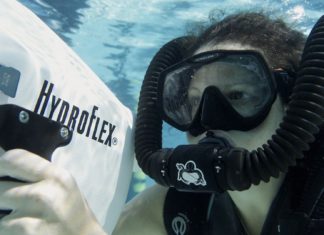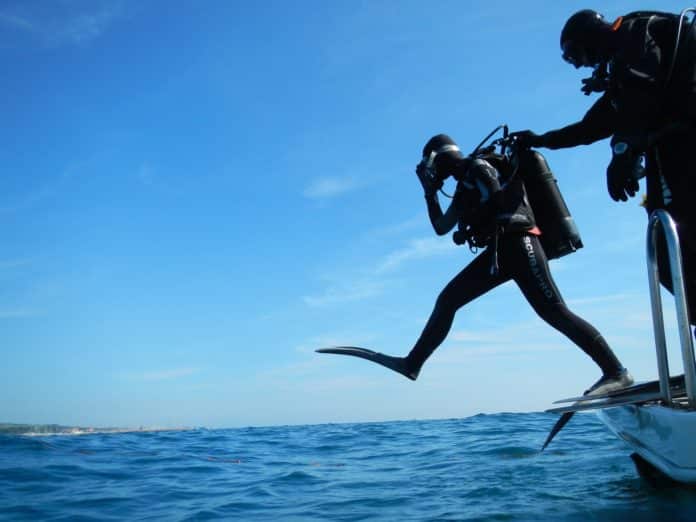
With any sport, maintaining a good level of fitness will always make it more enjoyable and easier to perform, and scuba diving is no different. Try running 10 kms with no previous training, then do it again six months later after consistent training and compare your times, and I am sure you will see an improvement. Scuba diving is the same. Maintaining your fitness will help with such things as air consumption and your ability to help in an emergency situation. So what do we need to do to keep ourselves fit for diving and are there specific workouts for scuba divers?
Workouts for Scuba Divers
When you think of diving you would not think you would need to be overly fit, as in theory, we are just swimming slowly weightless underwater. It’s not exactly the most demanding activity when you compare it to other sports, or is it?
A full set of scuba equipment can weigh around 20kg (44lbs), and this is before you add any extra weights needed for buoyancy. Just standing on-land, carrying your scuba equipment for a short time will begin to feel very heavy, especially on your back and shoulders. Luckily, once in the water the kit feels a lot lighter.
Depending on your dive location you may be required to walk some way in your equipment to your entry point, or even do multiple trips carrying equipment to the dive entry spot. This can be very physically demanding.
Once we are in the water on our dives, we still use more energy than you might imagine. Research has shown that while scuba diving you can burn between 400 – 700 calories an hour. Some variables such as temperature of water, currents and amount of exercise performed during the dive will affect the actual amount.
To compare that to running, a general estimate for calories burned is about 100 per mile. So running at a pace of one mile every 10 mins you would burn about 600 calories. Obviously this number can be affected by differences in body weight.
Given the choice between running for one hour and going on a dive for an hour, I know which one I would choose.
Workouts for scuba divers are workouts that will benefit you as a diver. This will include any kind of cardio, from walking, running, using a cross trainer or even an exercise bike. These types of exercises will really help build your stamina, increase your lung capacity, and help you feel less tired after diving.
Other good workouts for scuba divers would be strength training, especially in your legs, as this helps you carry the weight of the gear and can also help you kick in strong currents. Training your upper body can also help. Arms, back and shoulders will all be used when putting your equipment on and taking it off again, and also when carrying equipment to and from the dive site.
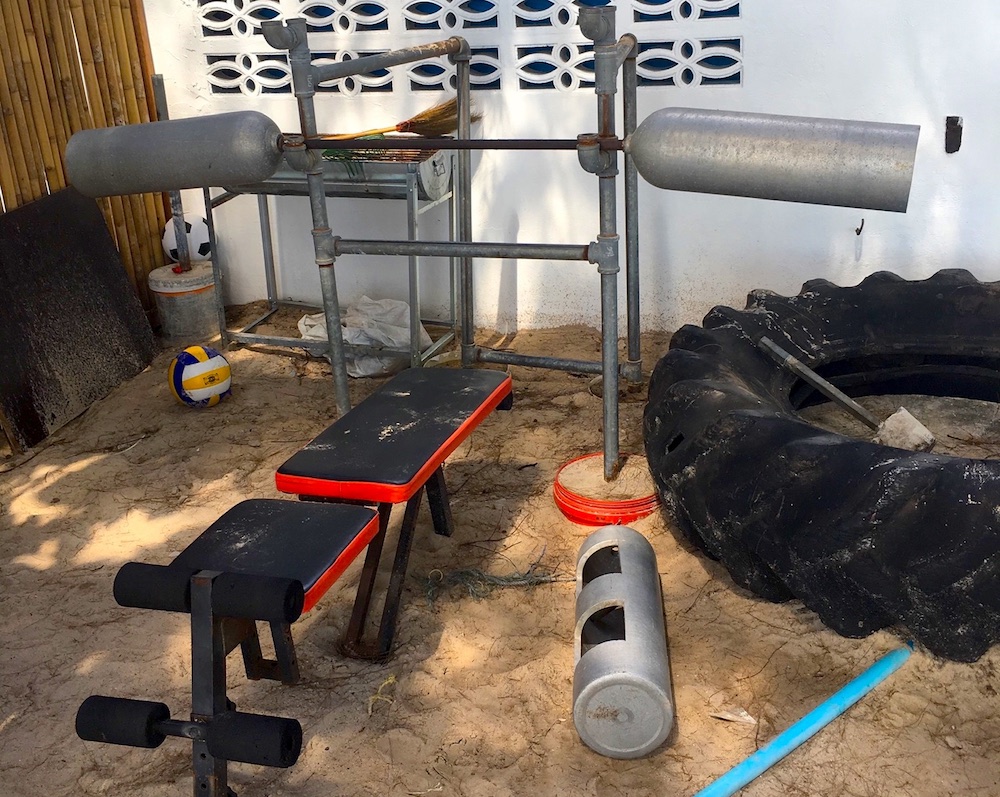
Exercises to Prepare for Scuba Diving
There are three main areas that you should focus on when training for diving. Cardio, Legs and Core muscles are key areas to focus on when preparing workouts for scuba divers. We will also look at what we can do to help with our upper body as well.
Cardio Workouts for Scuba Divers
For most people, doing cardiovascular exercises can feel like a bit of a chore. From my own experience, it is my least favorite thing to do in my workouts. However, it is very important to work the heart and lungs to increase our fitness and stamina levels.
The great thing with cardio is you can do it in so many different ways which can keep it fun and challenging. Most gyms will have treadmills, cross trainers, static bikes, rowing machines and more. HIIT (high-intensity interval training) classes are also a great way of getting a cardio workout if you are short on time, and these can be done either at a gym or home.
Any of these will give a good cardio workout. If you don’t have access to a gym or are lucky enough to have hiking trails nearby, then a hike is a great fun way to get your cardio workouts in, plus the scenery is usually a lot nicer.
Leg Workouts for Scuba Divers
Any diver will tell you that most of our movement is done by our legs while in the water. As divers, we try to move as little as possible to conserve energy and air (so we can get a longer dive underwater). This means our legs are the most used body part.
Kicking in strong currents, standing up from a seated position with the tank on your back, or just getting back on a boat using a ladder, takes strength from your legs. There are also emergency rescue scenarios in certain scuba diving courses which require you to practice towing and even carrying another diver back on a boat or to shore.
Divers have also been known to mention their calves hurting after scuba diving. This is due to pointing your toes to maximise the fin kick underwater. To use the most efficient kick in diving requires using your calf muscles, so it’s a good idea to strengthen these too.
Recommended exercises to help with your leg strength would be:
- Squats* – either with weights, air squats or against a wall
- Lunges* – depending on ability with or without weights is fine
- Calf Raises* – rolling to the balls of your feet while holding weights will work best
- Leg Extensions – this will help strengthen the quads (front thigh)
- Hamstring Curls – these focus on the back of the thigh (hamstring)
*These exercises can be performed at home.
Core Workouts for Scuba Divers
Just how much work our core muscles do during a dive trip surprises a lot of people. Maintaining trim position requires being in a position that we don’t usually find ourselves in, where we arch our back with feet and head up. This can result in people saying that their backs hurt after a dive.
Muscles always work in pairs, so if we are using our back muscles we will also be using our stomach muscles (abdominal). This means we need to train both to make sure they are evenly strong.
Some good exercises to do for your core and abdominal strength would include:
- Planking – holding your body tight while resting on your hands or forearms will really work your abs. It’s harder than it looks.
- Superman – this involves laying on your front hands either stretched out or fingers together behind your head, then lifting your legs and torso off the floor, really working on the lower back.
- Stomach crunches (sit ups) – can be performed in many different ways. It can be done in the decline position to add an extra degree of difficulty. Remember to focus on your abs.
- Flutter Kicks – laying on back hand down by your sides, lift legs from the floor, now kick alternate legs without touching the floor. This will work both abs and lower back while also replicating the kicking movement from scuba diving.
These are the main exercises that will help with diving fitness.
Upper Body Workouts for Scuba Divers
Other exercises that will help with your back, shoulders, and arms are:
- Lat Pull downs (back) – this will work the middle of your back and will help strengthen the muscles used when wearing the equipment. It is also very helpful if you have to lift tanks around, as these are the muscles that perform that movement.
- Shoulder press – can be performed with weights or a resistant band. This works the shoulders, which will really help when lifting equipment up for buddies or moving dive equipment around at piers or dive shops.
- Bicep curls – when diving we don’t use our hands or arms that much, are strength is helpful before and after the dive. Lifting bags of equipment, moving tanks, setting up weight belts all require the use of your arms.
**Before starting any fitness program, consult a doctor and seek advice from a qualified trainer on the best workout plan for you.
Exercises for Snorkeling
Snorkeling only requires a very basic level of fitness. This is because there is no heavy scuba equipment to carry around. If you are a good swimmer and comfortable in the water, then you can start snorkeling just about anywhere with a mask and snorkel. Snorkeling with fins can help if you plan on moving around a lot, but swimming bare feet is fine as well.
Making sure you have enough stamina to swim back to shore or back on the boat when you are finished with snorkeling is very important. It can be very easy to get distracted by all the amazing marine life, end up swimming far, and then finding yourself quite far from safety.
As with scuba diving it is mostly your legs that are involved in snorkeling, so any leg exercises such as squats and lunges would be very beneficial.
Other exercises to help with snorkeling would be cardio exercises; running, walking, cycling or HIIT classes at gyms. This will really increase your stamina and definitely help if you feel like doing a duck dive and holding your breath while exploring underwater.
Read More: Learn How to Snorkel
Scuba Diving Fitness Requirements
For any open water diver certification a medical questionnaire will be required to be completed before commencing the course. This questionnaire will have various questions about potential health problems that could be an issue while diving. If any question is answered ‘Yes’ then clearance from a medical professional will need to be given before diving can commence.
There are two in-water assessments that also need to be completed for certification. These are a 200 meter swim test and 10 minutes of treading water or floating. Many people are not aware that these skills are required for the Open Water certification. These assessments are to ensure that in an emergency you will have the stamina to either swim to help or remain on the surface of the water until help arrives.
While swimming 200 m and floating for 10 minutes can seem easy, these assessments can actually end up challenging most decent swimmers. Remember, swimming is a full body workout, and requires a good level of fitness. Depending on the person, floating on the surface of the water with no buoyancy aid for 10 minutes can be as easy as laying in the bath, or for others, like me, it requires a lot of effort and can be very challenging.
When training at the professional diving levels such as becoming a Dive Master, these swim tests are made that bit more difficult. You will be required to complete a 15 minute tread/float with no hands allowed to be used in the last two minutes, a 400m swim, a 800m snorkel and a 100m tired diver tow. These are all timed with scores given between 1-5.
Having a good level of fitness for either recreational or professional diving courses will benefit you greatly, and make the experience all the more enjoyable.
How to Work Out with your Dive Gear
Using your dive gear to work out can be a fun and creative way to mix up your workouts while also strengthening the specific muscles we use in diving.
If you have your own scuba gear with you at home then you can perform some good workouts with minimal equipment. All you will need is a BCD, weights and weight belt.
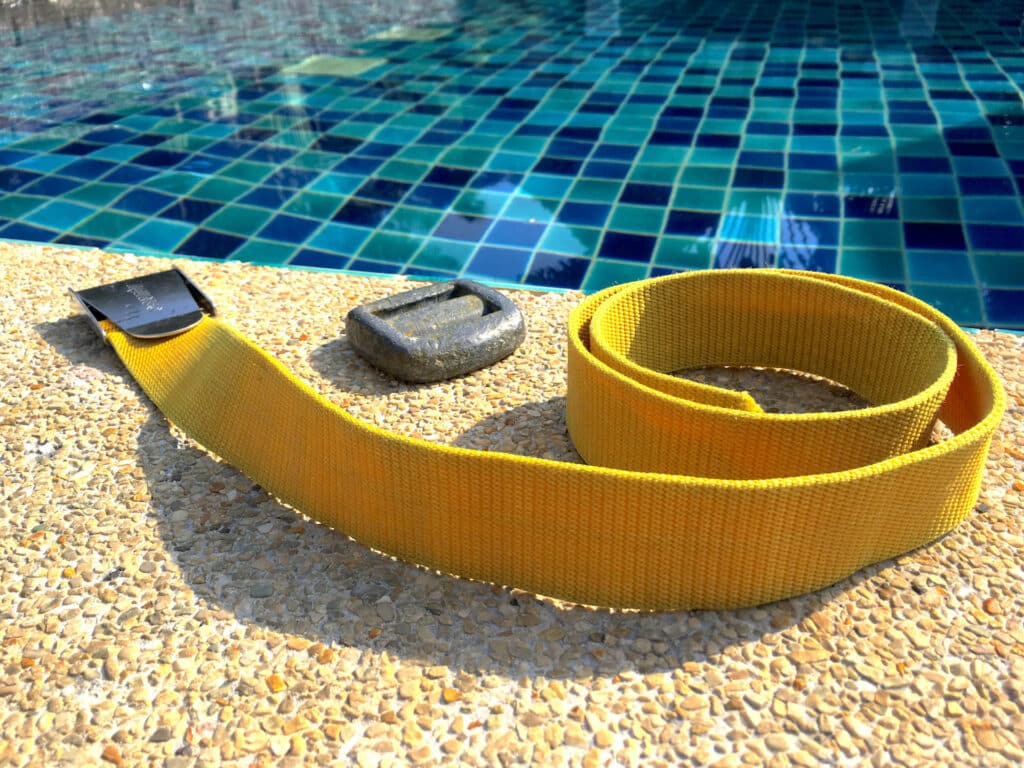
Using your BCD with weights in the pockets, you can perform lunges, squats, weighted push-ups and depending on ability, even weighted pull ups. Athletes who practice CrossFit will often wear weighted vests to increase the difficulty of exercises, and using your BCD can be a great way of replicating this.
Having weights on weight belts can enable you to perform quite a few exercises, such as bicep curls, shoulder raises, behind-the-head tricep extensions and even shoulder presses.
You can be very creative with your workout, depending on what you have laying around. During the Covid-19 lockdown of 2020, gyms were closed but I wanted to carry on working out. I managed to rig myself a weight station from some old tanks and weight belts. Luckily, there was an old bench and some scaffolding already set up so I adapted these into a bench press and dip station.
Using two old tanks, a bar and some weights on belts, I was able to do a full body workout. This included bench press, arm curls, shoulder press, squats, deadlifts and more. This kept me going until the gyms opened up again. As you can see using scuba equipment can be a great way to add to or even create new workouts.
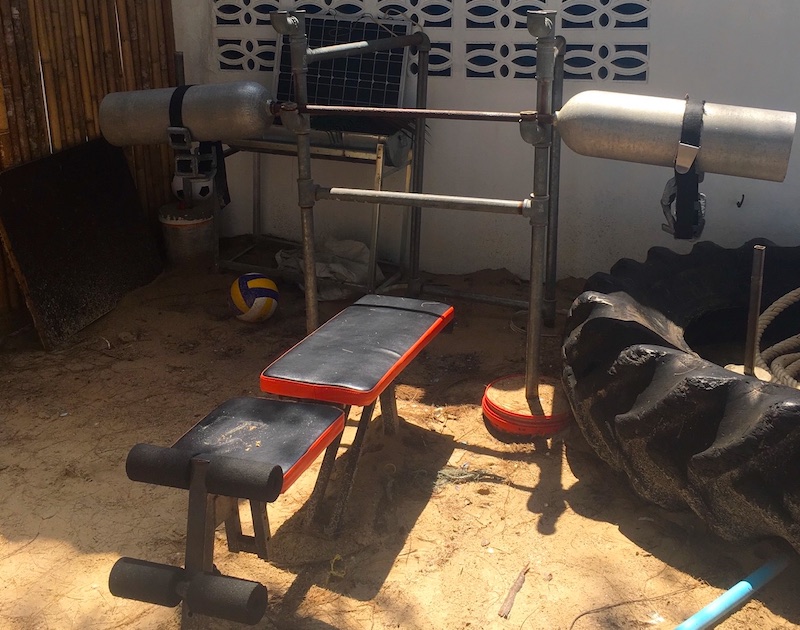
Military Scuba Exercises
If you are looking for ultimate scuba fitness then look no further than the workouts for military scuba divers. Now obviously anybody wishing to enlist into the military needs to be physically fit. Here is an example of a workout designed to help people pass the physical requirements for entry into the US Navy to become navy divers.
As you would imagine, these are pretty intense but you can see some of the same exercises that we recommend are used by the military as well. Below are three different workouts that would help build stamina and strength for diving and military fitness.
| Human Performance Test | Tactical Fitness | Tactical Strength Test |
|---|---|---|
| 800m Swim | 500m Swim plus 25m Buddy Tow | 500m Swim any stroke |
| 3 Mile Run | 3 Mile Run | Kettlebell / Snatch 5min test 30% bodyweight |
| Standing Long Jump | 400m Sprint | 1-2 x Bodyweight Squat |
| Bodyweight Bench Press (Max Reps) | Bodyweight Bench Press Max. Reps | 1 Rep Max Bench Press |
| 1 Rep Max. Deadlift | 1.5 Bodyweight Deadlift Max. Reps | 1.5 – 2 x Bodyweight Deadlift |
| Pull Ups (25lb vest) Max. Reps | Pull Ups with 25lb vest Max Reps | Pull Ups with 25lb vest |
| 300 Yard Shuttle runs (12 x 25 yards) | 300 Yard Shuttle runs (6 x 50 yards) | 300 Yard Shuttle runs (12 x 25 yards) |
| Plank 1-5 minutes | Strongman Hang from Bar for time | |
| 100m Fireman Carry (equal body weight) | 4 Mile Run with 50lb Rucksack | |
| 4 mile run with 50lb rucksack |
Keeping Fit for Diving
Keeping a good level of fitness is good for you, whether you are a scuba diver or not. If you are lucky enough to dive regularly or work in the diving industry, then keeping your fitness levels up is pretty easy as you will be using the muscles and cardiovascular system regularly. However, for many of us who are not able to dive regularly or only dive every few years or so, then staying fit is something you need to consider before jumping in for a dive.
Staying fit for diving is something that many of us may neglect or not really think about. It is easy to forget the physical demands of diving if you are not diving frequently. Being fit to dive will really help improve the enjoyment of diving, make you feel safer, and more confident in the water. Workouts for scuba divers doesn’t have to be super intense military-style, but doing some basic cardio, leg, and core work goes a long way in maintaining a good level of fitness for diving.
Using scuba equipment can also be a good way to mix up your workouts or help if you are unable to get to a gym. Remember that bodyweight exercises such as planks and push ups are a great way to workout as well. Whatever workout or exercises you choose does not really matter too much. As long as you are maintaining your fitness and are physically ready for your next dive then you will be sure to have fun!

















